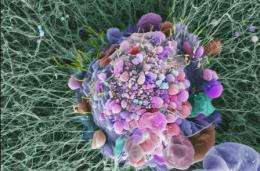Researchers aim to target achilles' heel of moving cancer cells

Cancer Research UK scientists are shedding new light on cancer spread – which could help in the development of new treatments for patients according to a study published in Nature Cell Biology.
The ability to spread is one of the most deadly properties of cancer cells. Their tendency to move from the original tumour site and colonise other parts of the body causes the greatest number of deaths from cancer.
Scientists at the Cancer Research UK London Research Institute are looking at different types of cancer cell movement in order to help develop drugs that could prevent the disease from spreading.
Cancer Research UK scientists led by Erik Sahai and Paul Bates developed a computer model based on skin cancer cells that predicts how a cancer cell might move under different conditions.
The team looked at several types of cell movement such as 'crawling' or 'squeezing', which they examined in different environments such as flat surfaces, enclosed areas or meshwork (much like a spiders web) to see how the cell would behave.
They found that cancer cells use different types of movement depending on the type of environment they find themselves in. For instance, on a flat surface cells will usually 'crawl' along, whereas in webbed environment they are more likely to become rounder helping them 'squeeze' through the gaps.
The results open up the possibility of using these behaviours as a target for treatments to stop cancer cells from moving around the body.
Dr Melda Tozluoğlu, the lead author of the study, said: "For cancer to spread, cancer cells actually need to move inside the body, from one point to another, stop, and start a new tumour. Our work focuses on understanding how the cancer cells move in the body, so that we can hamstring them – lock them into place so that other treatments can destroy them.
"Our study shows that cancer cells need different molecular mechanisms to navigate in different environments, just like you would need light running shoes to jog in the park but strong boots to hike in hills in the rain.
"We also know that cancer cells have the ability to use all different methods of movement, so stopping just one route will not stop them spreading through the body. In other words, if we take their hiking boots away, they will switch to running shoes and, although they may not be as fast, they will keep moving. This means we need to use drugs that target the many different types of movement that cancer cells can take advantage of."
Dr Julie Sharp, senior science information manager at Cancer Research UK, said: "Stopping cancers from spreading to new parts of the body is an important aim of our researchers and it's essential for making treatments more effective."Research like this, which benefits our understanding of all types of cancer, will be central to the work at the Francis Crick Institute, a new super-laboratory in London headed by Professor Sir Paul Nurse, where scientists will tackle major diseases such as cancer using the very latest technologies."
More information: Tozluoğlu, M et al, Matrix geometry determines optimal cancer cell migration strategy and modulates response to interventions (2013) Nature Cell Biology. DOI: 10.1038/ncb2775


















